We’ve all spotted those cheerful little birds with rosy-red faces hopping around our backyards, but many of us don’t realize we’re looking at one of North America’s most adaptable songbirds – the house finch. These remarkable creatures have transformed from desert dwellers to urban companions, conquering cities and suburbs across the continent with their infectious songs and vibrant personalities.
Originally native to the western United States, house finches have become backyard favorites thanks to their friendly nature and stunning plumage. The males sport brilliant red coloring on their heads and chests, while females showcase beautiful brown streaking that’s equally captivating. They’re not just pretty faces either – these intelligent birds have mastered the art of city living better than almost any other species.
Whether you’re a seasoned birdwatcher or just curious about the colorful visitors at your feeder, understanding house finches opens up a intriguing area of avian behavior and adaptation that’ll change how you see your backyard forever.
Physical Characteristics of the House Finch Bird
House finches display remarkable sexual dimorphism and distinctive features that make them easily recognizable in urban environments. These adaptable songbirds possess exact physical traits that distinguish them from other finch species.
Male vs Female Appearance
Male house finches showcase vibrant red coloration on their heads, breasts, and rumps during breeding season. The intensity of red varies from bright crimson to deep rose depending on their diet and age. Female house finches exhibit brown and gray streaked plumage with subtle white markings on their underparts. Both sexes have brown wings and tails with darker streaking patterns.
Juvenile males initially resemble females until they develop their characteristic red plumage after their first molt. Males with poor nutrition may display yellow or orange coloration instead of the typical red hues.
Size and Build
House finches measure 5 to 6 inches in length with a wingspan ranging from 8 to 10 inches. These compact birds weigh between 0.6 to 0.9 ounces making them slightly smaller than American goldfinches. Their body structure features a stocky build with relatively short legs and a proportionate tail length.
Adult house finches maintain consistent sizing throughout their range with minimal geographical variation. Males and females share similar dimensions with no important size differences between sexes.
Distinctive Features
House finches possess thick conical bills perfectly adapted for cracking seeds and nuts. Their bills appear slightly curved at the tip with a dark upper mandible and lighter lower mandible. Brown eyes provide excellent vision for foraging and predator detection.
Notable features include distinct white wing bars visible during flight and a slightly notched tail. House finches display a characteristic undulating flight pattern with rapid wingbeats followed by brief glides. Their legs and feet appear dark brown or black with strong gripping capabilities for perching on various surfaces.
House Finch Bird Habitat and Distribution
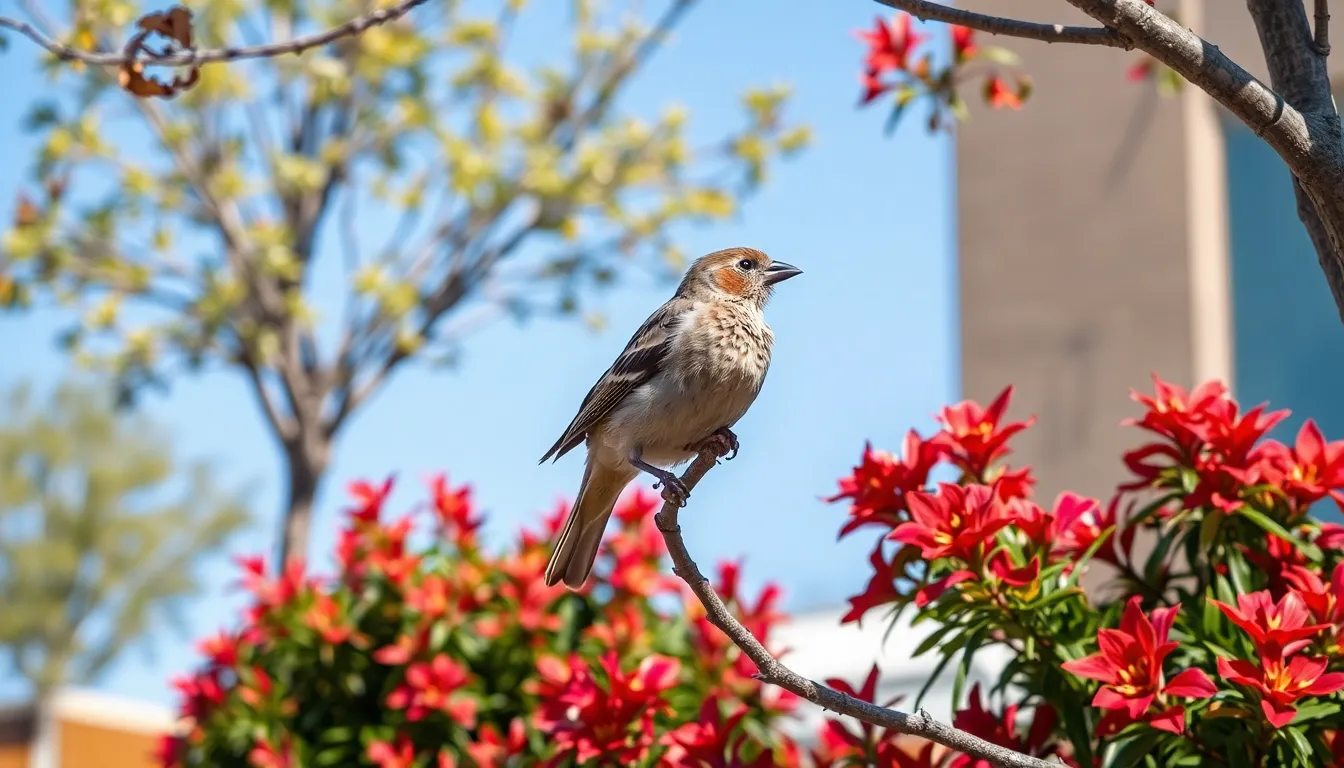
House finch birds demonstrate remarkable adaptability across diverse North American landscapes. These versatile songbirds have expanded far beyond their original western territories to establish thriving populations from coast to coast.
Natural Range and Migration Patterns
House finches originated in the western United States and Mexico, where they inhabited desert regions, chaparral, and oak woodlands from California to Texas. Eastern populations descended from birds illegally sold as “Hollywood finches” in New York City during the 1940s. Pet store owners released these captive birds when federal authorities cracked down on the illegal trade.
The eastern expansion created two distinct populations that gradually merged across the continent. House finches spread from their New York release point throughout the eastern United States within 50 years. Today they occupy territories from southern Canada to central Mexico and from the Atlantic to the Pacific coasts.
Unlike many songbird species, house finches don’t migrate seasonally. Residents remain in their territories year-round, though northern populations may move short distances southward during harsh winters. Mountain populations often descend to lower elevations when snow covers high-altitude food sources.
Preferred Environments
House finches thrive in human-modified landscapes more than pristine wilderness areas. Urban centers provide abundant food sources through bird feeders, ornamental plants, and fruit trees. Suburban neighborhoods offer ideal nesting sites in eaves, hanging planters, and decorative shrubs.
Agricultural regions attract house finches with grain crops, orchards, and farmyard bird feeders. These areas provide consistent food supplies throughout the year, supporting dense breeding populations. Open woodlands and forest edges serve as natural habitats where human development remains minimal.
Elevation ranges from sea level to 9,000 feet accommodate house finch populations across varied climatic zones. Desert regions of Arizona and Nevada host stable populations that exploit cacti fruits and desert wildflower seeds. Coastal areas from California to Maine support year-round residents that benefit from milder winter temperatures.
Parks, golf courses, and cemetery grounds create urban oases that concentrate house finch activity. These managed landscapes combine open foraging areas with scattered trees for nesting and roosting. Residential gardens with native and exotic plants extend suitable habitat into densely populated metropolitan areas.
Diet and Feeding Behavior
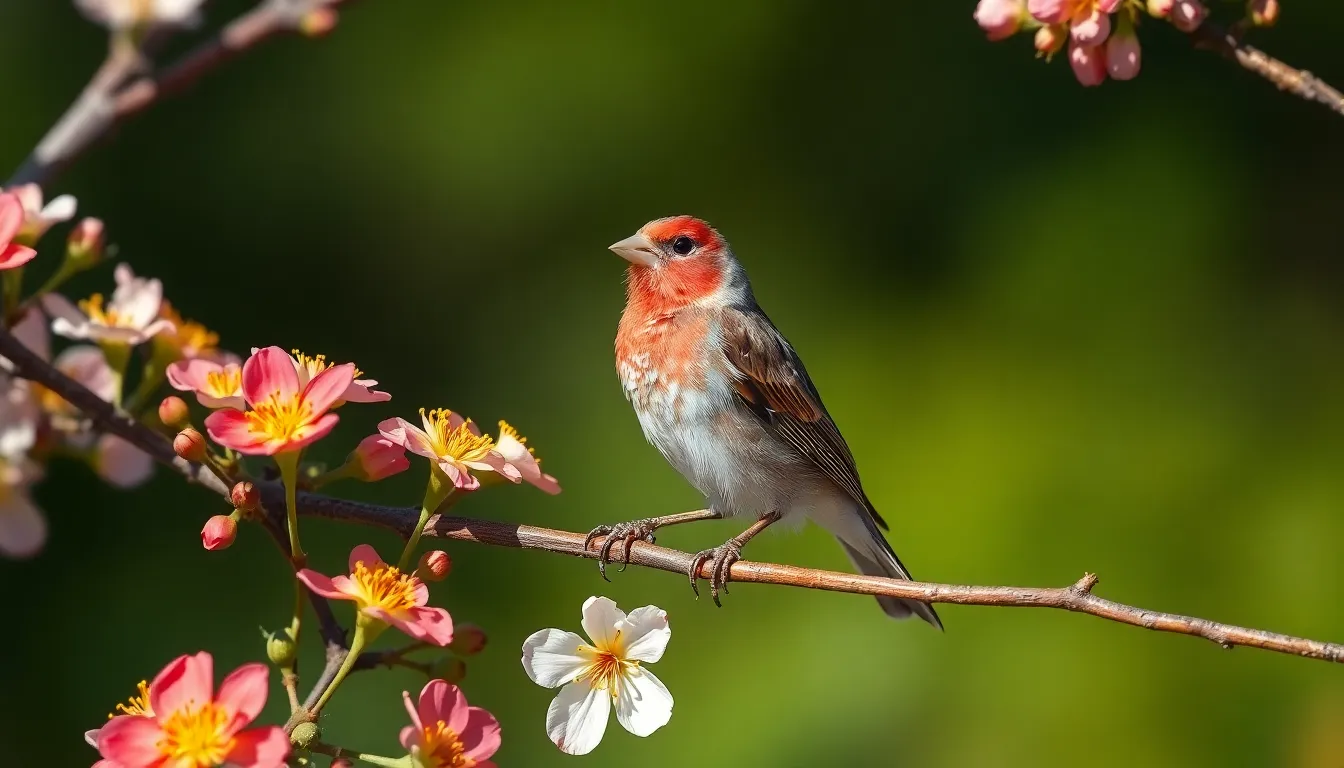
House finches demonstrate remarkable dietary flexibility that contributes to their widespread success across diverse North American environments. These adaptable songbirds consume both plant and animal matter throughout the year.
Natural Food Sources
Seeds form the primary component of the house finch diet, comprising approximately 97% of their annual food intake. Dandelion seeds, sunflower seeds, and thistle seeds rank among their preferred choices during spring and summer months.
Elm buds provide essential nutrients during late winter when other food sources become scarce. House finches also consume:
- Tree fruits including mulberries, cherries, and apricots during peak ripening seasons
- Flower petals from tulips, daffodils, and fruit tree blossoms in early spring
- Tender plant shoots from various grasses and herbaceous plants
- Small insects such as aphids and caterpillars during breeding season to feed protein-rich meals to nestlings
Agricultural crops attract house finches to farming regions where they feed on corn kernels, wheat grains, and oat seeds. Native plant species like elderberry and poison oak berries supplement their diet in natural habitats.
Feeding Habits and Foraging
House finches exhibit gregarious feeding behavior, often foraging in flocks of 10 to 50 individuals outside the breeding season. These social groups provide protection from predators while maximizing food discovery efficiency.
Ground foraging represents their primary feeding method as house finches hop along surfaces searching for fallen seeds. Their thick conical bills crack open tough seed shells with remarkable precision, allowing access to nutrient-rich kernels inside.
Acrobatic feeding behaviors emerge when house finches target hanging seed heads or fruit clusters on trees and shrubs. They hang upside down from thin branches to reach food sources that larger birds cannot access.
Dawn and dusk mark peak feeding periods when house finches are most active. Morning foraging sessions typically last 2 to 3 hours after sunrise, while evening feeding occurs 1 to 2 hours before sunset.
Backyard bird feeders attract house finches throughout the year, with nyjer seed and black oil sunflower seed proving most popular. These urban feeding opportunities have contributed significantly to their population expansion in residential areas across North America.
House Finch Bird Behavior and Social Structure
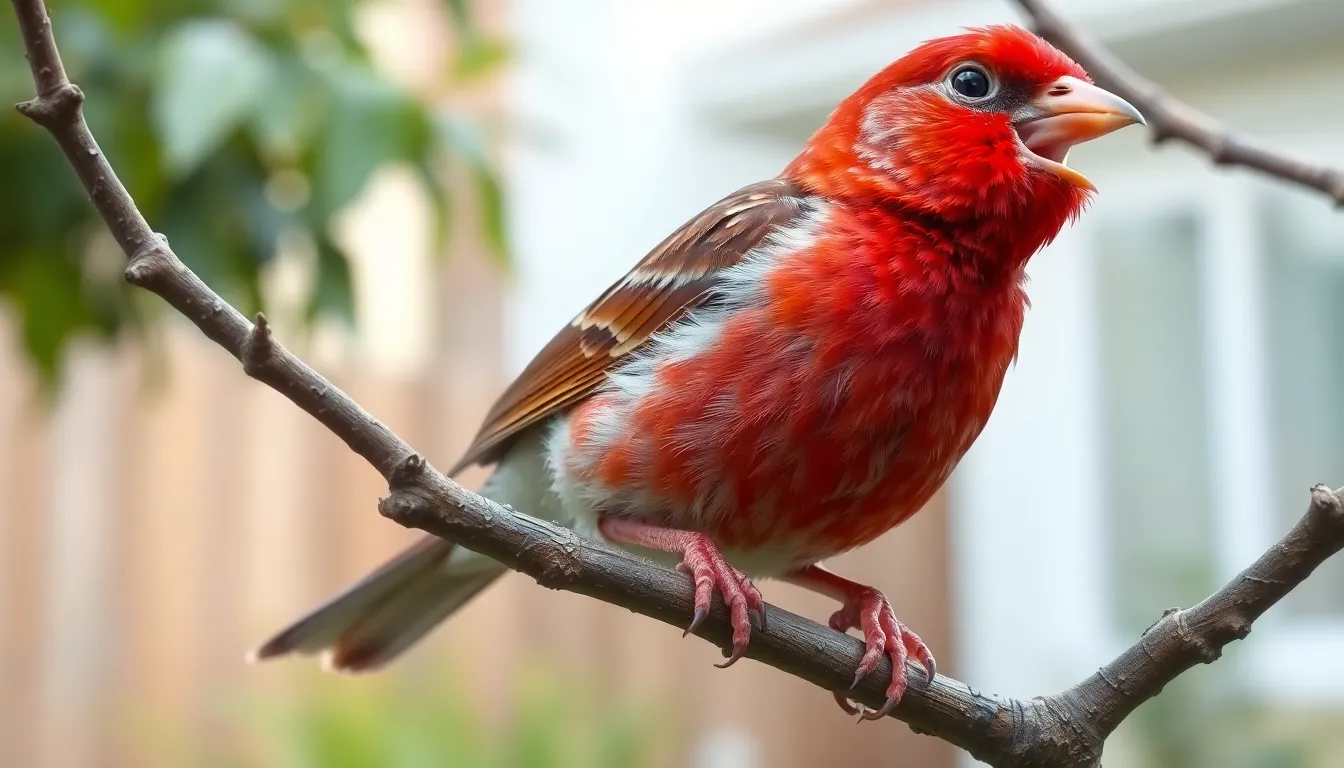
House finches demonstrate complex social behaviors that vary significantly throughout their annual cycle. These adaptable songbirds form intricate community structures centered around breeding partnerships, territorial nesting, and seasonal flocking patterns.
Mating and Breeding Patterns
House finch courtship begins in late winter when males establish breeding territories through persistent singing and vibrant plumage displays. Males perform elaborate courtship rituals including wing fluttering, head bobbing, and offering food to prospective mates. Females select partners based on the intensity of red coloration, which indicates genetic fitness and foraging ability.
Breeding occurs between March and August, with pairs producing 2 to 6 broods annually in favorable conditions. Monogamous pairs maintain their bond throughout the breeding season, though some individuals change partners between broods. Males actively defend small territories around nesting sites, typically spanning 50 to 100 feet in diameter.
Female house finches lay 2 to 6 pale blue eggs with dark speckles after a 12 to 14 day incubation period. Males contribute to parental care by feeding females during egg laying and bringing food to nestlings throughout the 12 to 19 day fledgling period.
Nesting Habits
House finches construct cup-shaped nests using twigs, grasses, and artificial materials like string or paper strips. Females select nesting sites in shrubs, trees, building ledges, or decorative structures between 4 and 20 feet above ground. Urban populations frequently choose hanging planters, porch lights, and building eaves for nest placement.
Construction takes 2 to 6 days, with females weaving materials into a compact structure measuring 3 to 4 inches across. Nests feature soft interior linings made from feathers, hair, or fine plant fibers. Pairs often reuse successful nesting locations across multiple broods, rebuilding structures rather than renovating existing ones.
House finches demonstrate remarkable nest site flexibility, adapting to human environments by utilizing artificial structures when natural options are limited. Cavity nesting occurs occasionally in birdhouses, hollow fence posts, or building crevices.
Flock Dynamics
House finches form loose feeding aggregations outside the breeding season, with flocks ranging from 10 to 100 individuals. These social groups provide protection through increased vigilance and shared foraging information. Flock composition changes frequently as birds move between food sources and roosting areas.
Hierarchical structures emerge within flocks, with older males typically dominating feeding sites during winter months. Aggressive interactions include bill pointing, wing spreading, and brief chasing sequences to establish pecking orders. Subordinate birds wait their turn at feeders or seek alternative feeding locations.
Communication within flocks involves varied vocalizations including contact calls, alarm notes, and location signals. Birds maintain visual contact while foraging, using flight calls to coordinate group movements between feeding areas. Roosting behavior becomes communal during cold weather, with multiple individuals sharing sheltered locations for thermal regulation.
Identifying House Finch Bird Calls and Songs
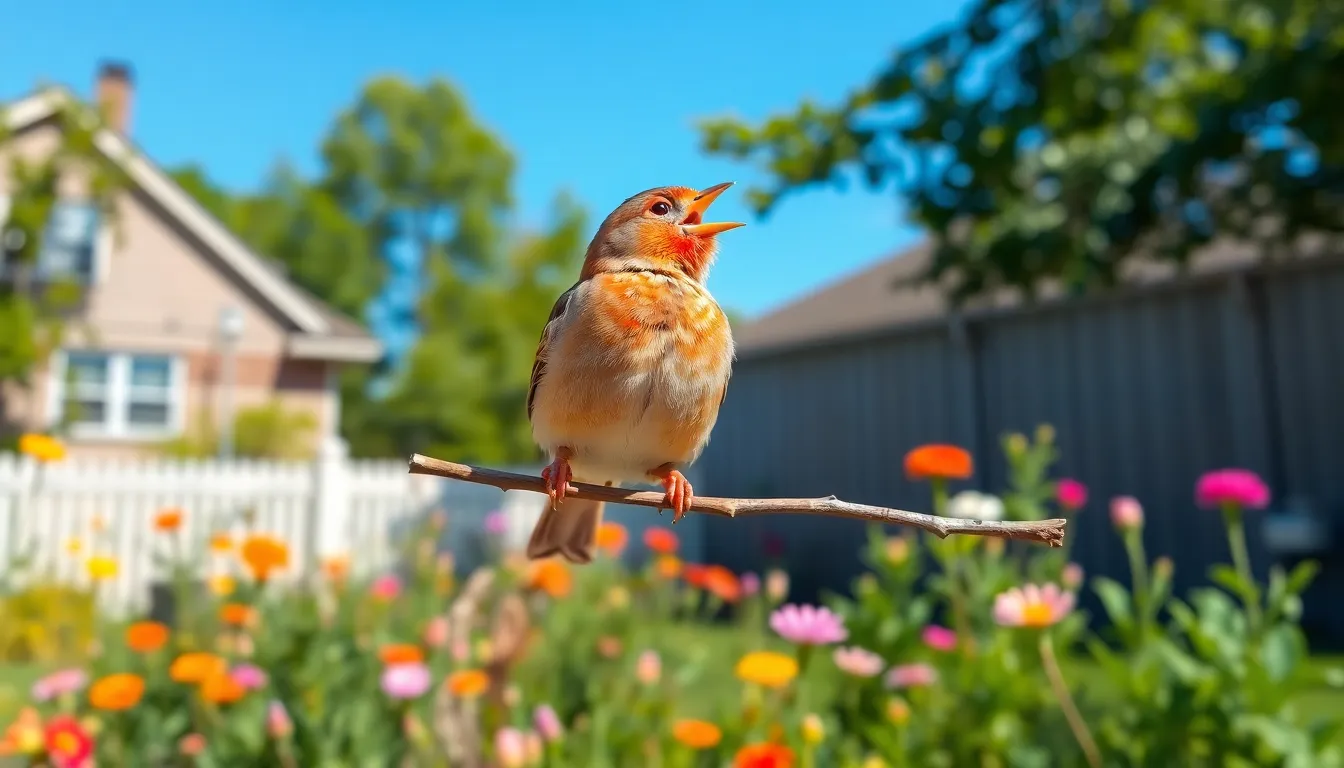
House finch vocalizations create one of the most recognizable soundscapes in North American backyards and urban environments. We can distinguish these adaptable songbirds through their distinctive warbling melodies and conversational chatter that echoes throughout their territories year-round.
Vocal Characteristics
House finches produce complex musical phrases that typically last 2 to 3 seconds and contain 10 to 20 individual notes. Males deliver the most elaborate songs from prominent perches during breeding season, combining rapid trills with clear whistles in frequencies ranging from 2,000 to 8,000 Hz. Their songs often begin with introductory notes followed by a warbling sequence that ends with distinctive buzzy or raspy sounds.
Both sexes communicate through various call notes that serve different purposes throughout their daily activities. Flight calls consist of sharp “cheep” or “chirp” sounds that help maintain flock cohesion during movement. Contact calls feature softer conversational tones when birds forage together at feeding sites or interact within their territories.
Female house finches produce shorter vocalizations compared to males but maintain active vocal participation during pair bonding and nest building activities. Their calls typically include gentle “wheep” sounds and brief chattering sequences when communicating with mates or defending nesting areas.
Juvenile house finches develop their vocal repertoire through learning from adult males in their vicinity. Young birds practice subsong vocalizations that gradually develop into full adult songs by their first breeding season at approximately one year of age.
Seasonal Variations
Spring brings the peak vocal activity for house finches as males establish territories and attract mates through intensified singing behaviors. March through July represents the primary singing period when we hear the most elaborate and frequent vocalizations throughout daylight hours. Males often sing from the same perches repeatedly, creating familiar dawn and dusk choruses in residential neighborhoods.
Summer vocal patterns shift toward shorter song phrases as breeding pairs focus energy on nesting and raising young. Parents use quiet contact calls near nest sites to avoid attracting predators while maintaining communication about feeding duties and territory defense.
Fall and winter months feature reduced singing frequency but continued social vocalizations as house finches form feeding flocks. Flock members use contact calls to coordinate movement between food sources and communicate about potential threats or rich foraging opportunities.
Weather conditions directly influence house finch vocal activity throughout the year. Clear sunny days trigger increased singing behavior while storms and harsh weather conditions suppress vocalizations as birds conserve energy for survival activities.
Human activity patterns in urban environments create unique seasonal variations in house finch vocal timing. Birds often adjust their peak singing periods to avoid competing with traffic noise and human activity during busy morning and evening commute hours.
House Finch Bird vs Similar Species
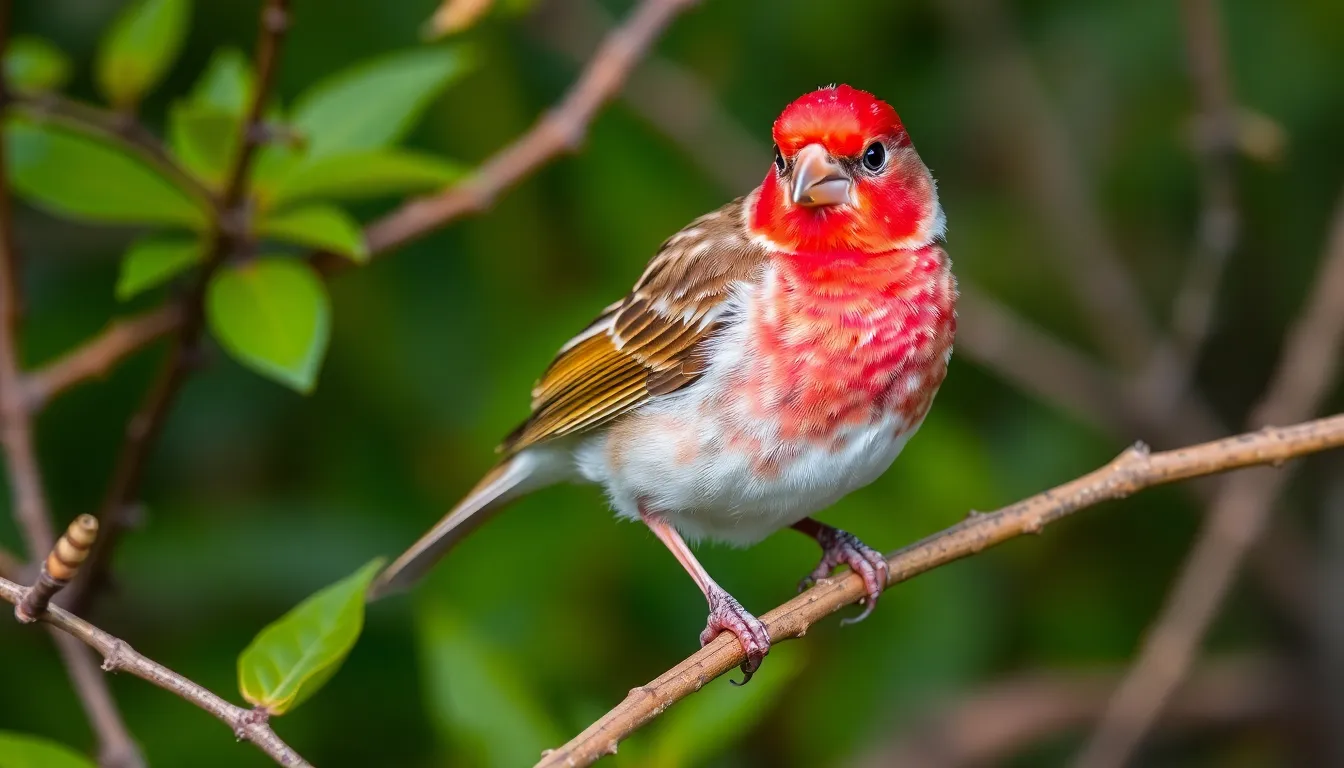
House finches share physical characteristics with several North American songbirds, making accurate identification challenging for backyard birdwatchers. We’ve compiled the most common misidentifications and distinguishing features to help you confidently recognize these adaptable urban songbirds.
Common Misidentifications
Purple finches create the most frequent confusion with house finches among birdwatchers across North America. Male purple finches display deeper raspberry coloration that covers their entire head and breast, contrasting with the house finch’s orange-red streaking pattern. Female purple finches show more pronounced facial patterns with distinct white eyebrows and mustache stripes.
Cassin’s finches represent another common misidentification in western regions where ranges overlap. Male Cassin’s finches feature bright red crown caps with pink-washed bodies, while house finch males show red primarily on the forehead and breast with brown streaking throughout.
Female house sparrows often confuse observers due to similar brown and gray coloring patterns. House sparrows display chunkier builds with shorter tails and lack the streaked underparts characteristic of female house finches. Sparrow bills appear more triangular compared to the house finch’s curved conical shape.
American goldfinches in winter plumage share brownish coloration with female house finches. Goldfinches maintain yellow tinges on their shoulders and show more compact body proportions with shorter, notched tails.
Key Distinguishing Features
Bill shape provides the most reliable identification feature for house finches among similar species. House finches possess curved conical bills perfectly adapted for seed cracking, while purple finches show straighter, more pointed bills. Cassin’s finches display longer, more slender bills compared to the house finch’s compact structure.
| Species | Bill Shape | Male Coloring | Female Pattern | Tail Length |
|---|---|---|---|---|
| House Finch | Curved conical | Red forehead/breast, brown streaks | Brown with heavy streaking | Medium, slightly notched |
| Purple Finch | Straight, pointed | Deep raspberry wash overall | White eyebrow, less streaking | Shorter, deeply notched |
| Cassin’s Finch | Long, slender | Red crown cap, pink body | Faint facial pattern | Longer, square-ended |
| House Sparrow | Triangular | Black bib, gray crown | Plain brown back | Shorter, rounded |
Tail characteristics offer additional identification markers for house finches. House finches display medium-length tails with slight notching, distinguishing them from purple finches’ deeply forked tails and house sparrows’ shorter rounded tails.
Flight patterns help differentiate house finches from similar species during observation. House finches demonstrate undulating flight with alternating flap-and-glide sequences, while house sparrows show more direct flight paths with rapid wingbeats.
Behavioral differences support visual identification of house finches in mixed flocks. House finches feed more acrobatically on seed heads and feeders compared to ground-feeding house sparrows. Purple finches prefer higher perches in trees while house finches readily use lower shrubs and human structures.
Attracting House Finch Birds to Your Yard
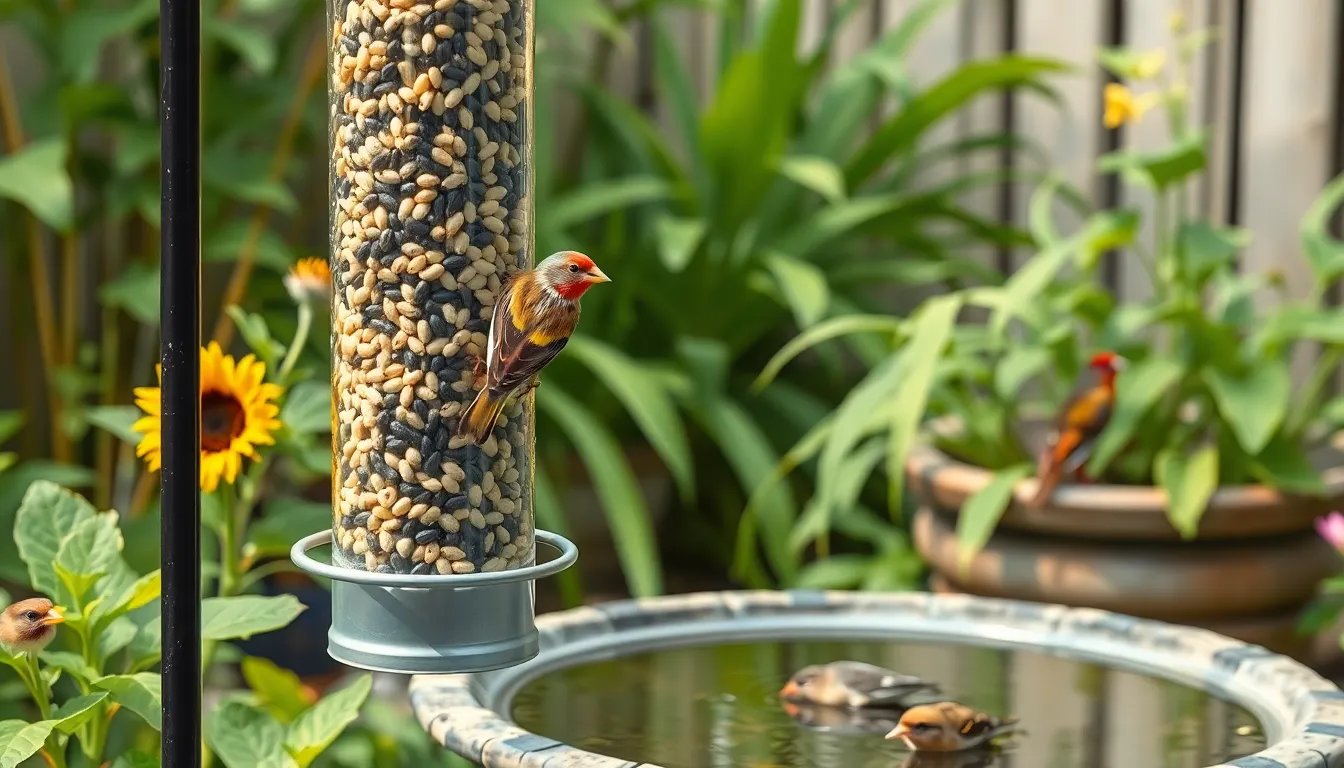
Successfully attracting house finches to your yard requires understanding their feeding preferences and environmental needs. These adaptable songbirds respond well to consistent food sources and suitable nesting opportunities.
Best Bird Feeders and Food
House finches prefer tube feeders with multiple perches that accommodate their gregarious feeding behavior. Platform feeders work equally well since they allow several birds to feed simultaneously. Nyjer (thistle) seed feeders attract house finches year round, while sunflower seed dispensers provide their most preferred food source.
Sunflower seeds rank as the top choice for house finch attraction, particularly black oil sunflower seeds which contain high fat content essential for their energy needs. Nyjer seeds offer excellent nutritional value and remain fresh longer in specialized tube feeders. Safflower seeds serve as an alternative option that squirrels typically avoid.
We recommend avoiding mixed seed blends that contain filler seeds like milo or wheat, which house finches commonly reject. Fresh seeds maintain higher appeal than stale options, so replace feeder contents every 2-3 weeks. Multiple feeder locations throughout your yard increase visitation rates since house finches forage in small flocks.
| Feeder Type | Best Seeds | Capacity | Maintenance |
|---|---|---|---|
| Tube Feeder | Black oil sunflower | 2-4 pounds | Clean weekly |
| Platform Feeder | Mixed sunflower/nyjer | 1-2 pounds | Clean daily |
| Nyjer Feeder | Thistle seeds only | 1-3 pounds | Clean monthly |
Creating an Ideal Environment
Water sources prove essential for attracting house finches since they drink regularly and enjoy bathing. Shallow birdbaths with depths of 1-2 inches accommodate their size perfectly. Moving water from drippers or small fountains increases attraction rates significantly.
Native plants that produce seeds create natural foraging opportunities throughout the year. Sunflowers, coneflowers, and black-eyed Susans provide seeds that house finches actively seek. Dense shrubs offer protection from predators and potential nesting sites within 10-15 feet of feeding areas.
Pesticide-free yards support house finch health since these birds occasionally consume small insects during breeding season. Brush piles constructed from natural materials provide shelter during harsh weather conditions. Cat deterrents become necessary since domestic cats pose the primary threat to backyard house finches.
Nesting opportunities increase when you provide suitable locations like dense shrubs, small trees, or artificial nesting platforms. House finches readily use hanging planters, porch lights, and building eaves for nest construction. Materials such as small twigs, grass, and feathers left in accessible areas assist their building efforts.
Consistent feeder maintenance and reliable water sources establish your yard as a dependable habitat that house finches visit daily throughout all seasons.
Conservation Status and Population Trends
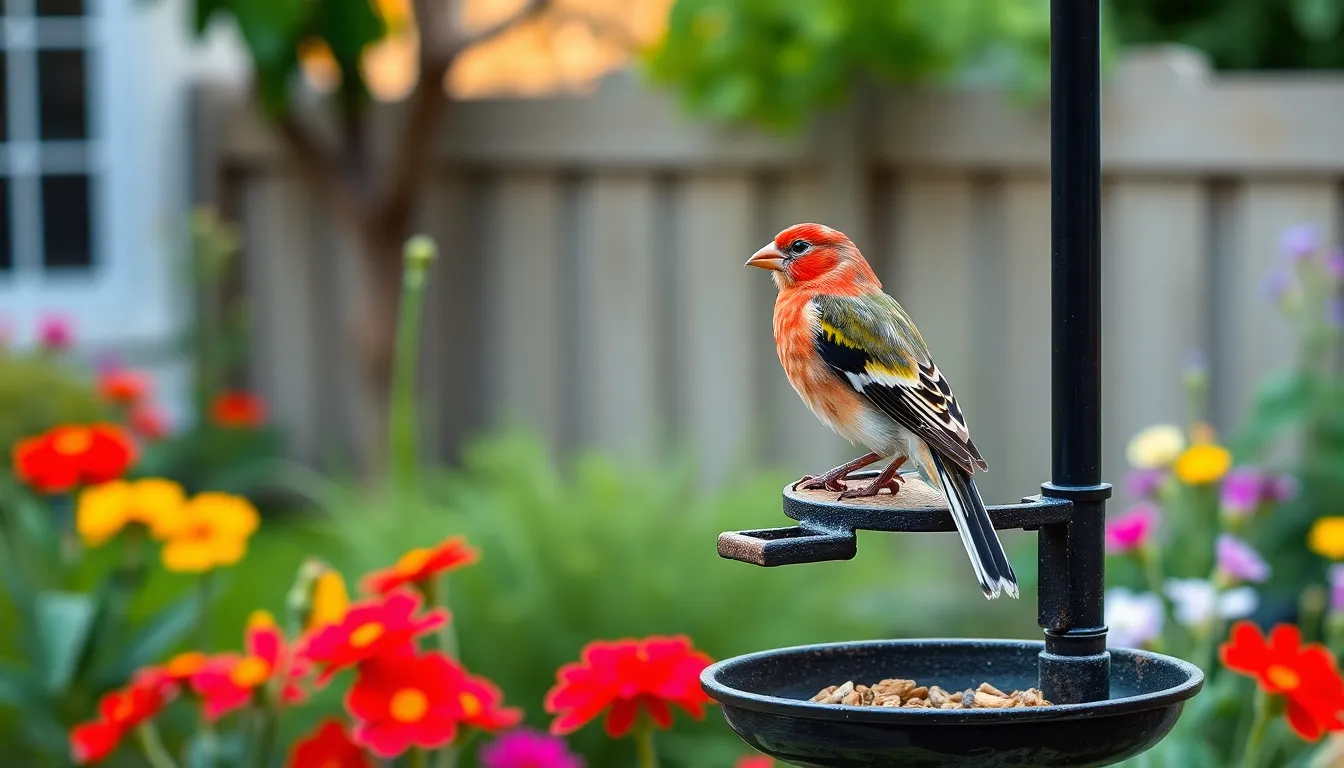
House finches currently maintain a stable conservation status across North America with populations estimated at 267 million individuals. The International Union for Conservation of Nature (IUCN) classifies house finches as a species of Least Concern due to their expanding range and robust population numbers.
Population trends for house finches show remarkable growth patterns since the 1940s when illegal pet trade releases introduced them to eastern North America. Christmas Bird Count data reveals consistent increases in house finch populations across 31 states between 1966 and 2019. Eastern populations expanded at an average rate of 13% annually during the initial establishment phase.
Breeding Bird Survey data indicates house finch populations increased by approximately 1.5% per year from 1966 to 2019 across their entire range. Western populations remained relatively stable while eastern populations continued expanding into new territories including Ontario Canada and northern regions previously unsuitable for year round residence.
| Population Metric | Value | Time Period |
|---|---|---|
| Total North American Population | 267 million | 2019 estimate |
| Annual Growth Rate (Eastern Range) | 13% | 1940s-1980s |
| Overall Population Trend | +1.5% yearly | 1966-2019 |
| Range Expansion | 31 states | Current distribution |
Threats to house finch populations remain minimal compared to other songbird species. House finch eye disease caused by Mycoplasma gallisepticum emerged in the 1990s affecting eastern populations but population recovery occurred within two decades. Urban development benefits house finches by creating additional nesting sites and food sources through bird feeders and landscaping.
Climate change poses potential long term challenges as temperature shifts may affect food plant distribution and breeding cycles. Northern populations show adaptation to changing weather patterns by adjusting migration timing and extending breeding seasons in warmer regions.
Habitat loss affects house finches less than other songbirds because they thrive in human modified environments. Agricultural expansion and suburban development often create favorable conditions for house finch populations rather than threatening their survival.
Conservation efforts focus on monitoring population health through citizen science programs like eBird and Project FeederWatch. These initiatives track house finch distribution changes and identify emerging threats before they impact population stability across their continental range.
Conclusion
House finches represent one of nature’s greatest success stories when it comes to urban adaptation. We’ve witnessed how these remarkable birds transformed from western desert dwellers into beloved backyard companions across North America.
Their thriving population of 267 million individuals proves that some species can flourish alongside human development. We can easily welcome these charming songbirds into our yards with simple feeders and fresh water sources.
As we continue to share our spaces with house finches we’re reminded that coexistence benefits both humans and wildlife. These adaptable birds will likely remain our faithful neighborhood companions for generations to come.
Frequently Asked Questions
What is a house finch and where do they come from?
House finches are small, adaptable songbirds originally from the western United States and Mexico. They measure 5-6 inches in length with an 8-10 inch wingspan. These birds successfully expanded across North America after illegal releases in the 1940s and are now found from southern Canada to central Mexico, thriving in urban and suburban environments.
How can I identify a male house finch?
Male house finches are easily identified by their vibrant red coloration on the head, chest, and rump during breeding season. They have thick conical bills, white wing bars, and a stocky build. Males are more colorful than females, who display brown and gray streaked plumage. Juvenile males resemble females until they develop their characteristic red hues.
What do house finches eat?
House finches have a diet consisting of approximately 97% seeds, with favorites including dandelion, sunflower, and thistle seeds. They also consume tree fruits, flower petals, tender plant shoots, and small insects during breeding season. Their thick conical bills are perfectly adapted for cracking open tough seed shells.
How can I attract house finches to my backyard?
Use tube and platform feeders filled with black oil sunflower seeds, which are their top choice. Nyjer seeds also work well for year-round attraction. Maintain fresh seeds, avoid mixed blends with fillers, provide water sources, plant native vegetation, and ensure consistent feeder maintenance while protecting from predators like cats.
Do house finches migrate?
Unlike many songbirds, house finches do not migrate seasonally and remain in their territories year-round. Some northern populations may move short distances during harsh winters, but they generally stay in the same area throughout the year, making them reliable backyard visitors.
What sounds do house finches make?
Male house finches produce elaborate songs during breeding season, while both sexes use various calls for communication. Their vocalizations create recognizable soundscapes in North American backyards. Peak singing occurs in spring, with vocal patterns shifting during summer and winter. Weather conditions and human activity influence their vocal behavior.
How do house finches behave socially?
House finches exhibit complex social behaviors with territorial males performing courtship rituals during breeding season (March-August). Outside breeding season, they form loose feeding flocks with hierarchical structures where older males often dominate feeding sites. They demonstrate communal roosting behavior during colder weather and use varied vocalizations for flock communication.
Are house finches endangered?
House finches maintain a stable conservation status with an estimated population of 267 million individuals. Classified as Least Concern by the IUCN, they’ve shown remarkable growth since the 1940s introduction to eastern North America. Population data indicates consistent increases across 31 states with minimal survival threats compared to other songbirds.
How do I tell house finches apart from similar birds?
House finches have curved conical bills, medium-length tails, and undulating flight patterns. They’re often confused with purple finches (which have straighter bills), house sparrows (which lack the conical bill), and American goldfinches (which are smaller with different coloring). Male house finches’ red coloring and behavioral traits like acrobatic feeding help distinguish them.
When do house finches breed and nest?
House finches breed from March to August, with females laying 2-6 eggs. They build nests in various locations, often utilizing human structures like building eaves, hanging planters, and outdoor fixtures. Males participate in parental care and establish territories during breeding season. They demonstrate remarkable flexibility in their nesting habits and site selection.

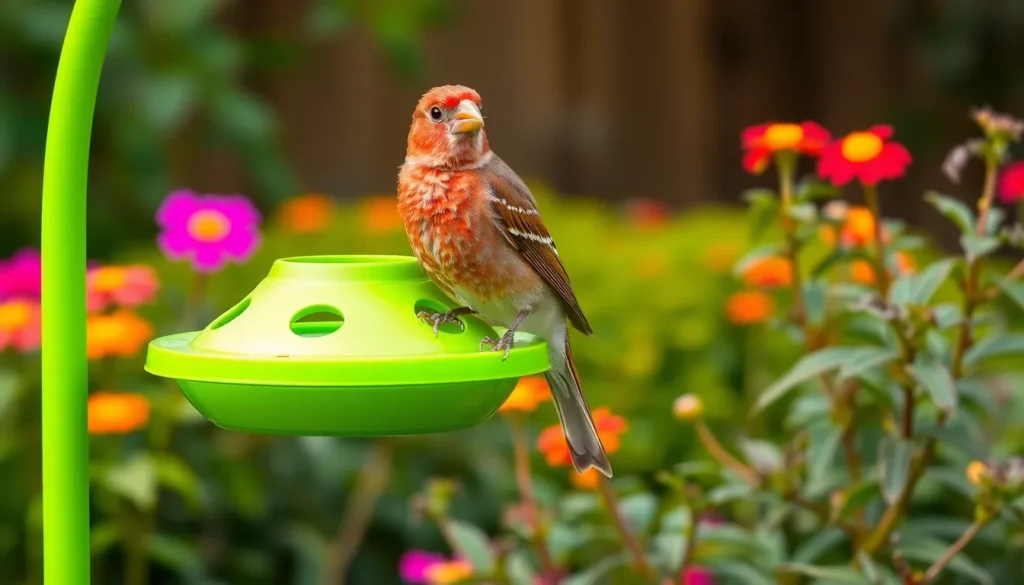




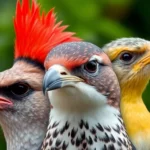

Very good blog! Do you have any hints for aspiring writers? I’m hoping to start my own site soon but I’m a little lost on everything. Would you propose starting with a free platform like WordPress or go for a paid option? There are so many choices out there that I’m totally overwhelmed .. Any recommendations? Many thanks!